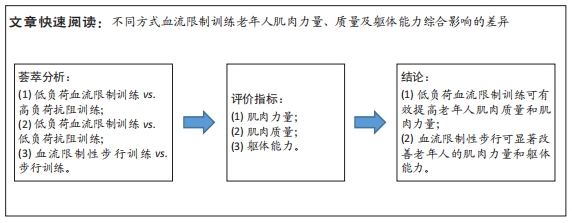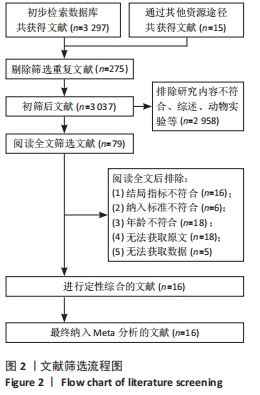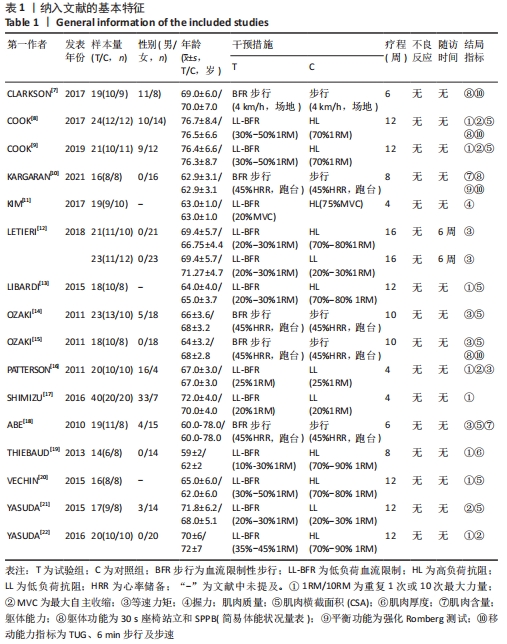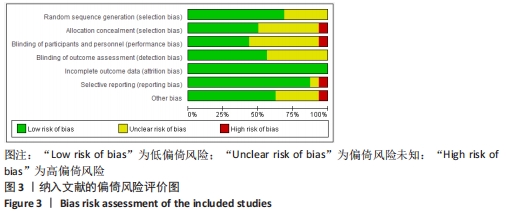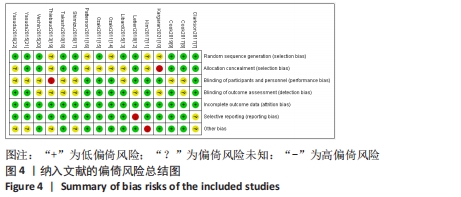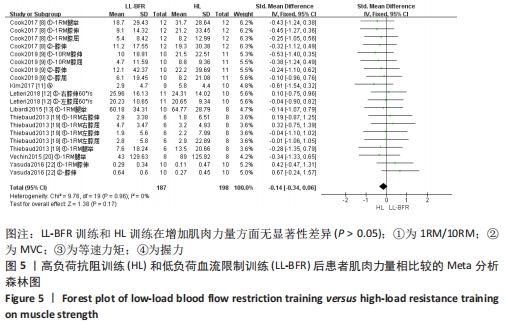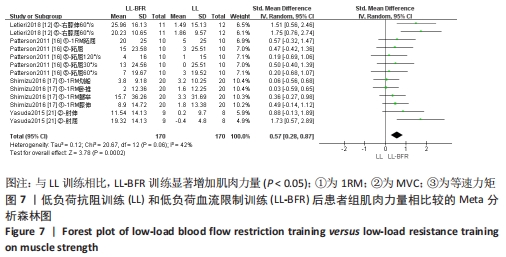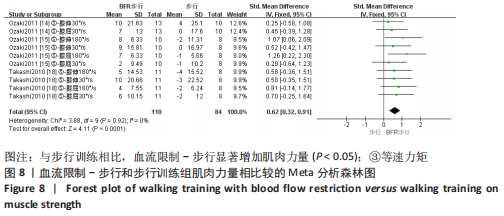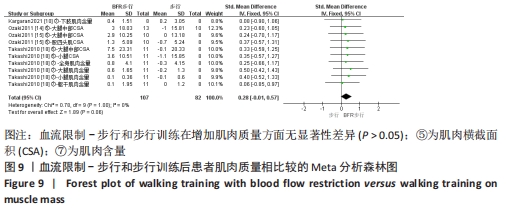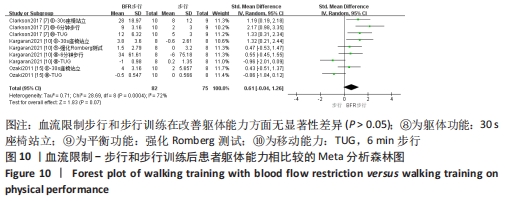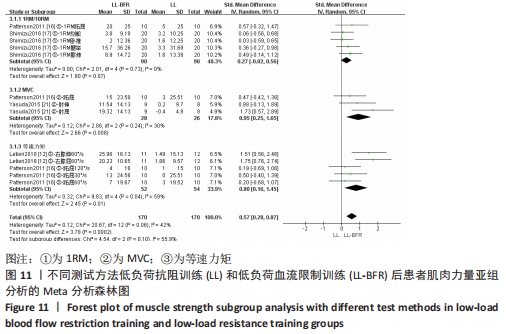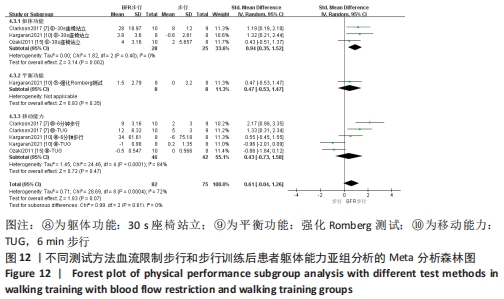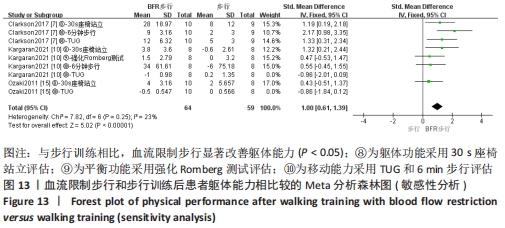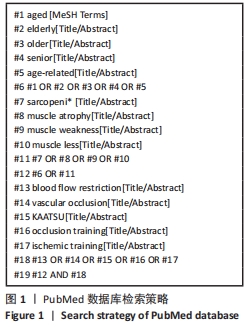[1] 姜珊,康琳,刘晓红. 2019亚洲肌少症诊断及治疗共识解读[J].中华老年医学杂志,2020, 39(4):373-376.
[2] FRAGALA MS, CADORE EL, DORGO S, et al. Resistance training for older adults: position statement from the national strength and conditioning association. J Strength Cond Res. 2019;33(8):2019-2052.
[3] LORENZ DS, BAILEY L, WILK KE, et al. Blood Flow Restriction Training. J Athl Train. 2021;56(9):937-944.
[4] WANG DXM, YAO J, ZIREK Y, et al. Muscle mass, strength, and physical performance predicting activities of daily living: a meta-analysis. J Cachexia Sarcopenia Muscle. 2020;11(1):3-25.
[5] 汪洋.Cochrane偏倚风险评估工具简介[J].中国全科医学,2019,22(11):1322.
[6] 刘鸣,吴红梅,卫茂玲.系统评价、Meta-分析设计与实施方法[M].北京:人民卫生出版社, 2011:68-71.
[7] CLARKSON MJ, CONWAY L, WARMINGTON SA. Blood flow restriction walking and physical function in older adults: a randomized control trial. J Sci Med Sport. 2017;20(12):1041-1046.
[8] COOK SB, LAROCHE DP, VILLA MR, et al. Blood flow restricted resistance training in older adults at risk of mobility limitation. Exp Gerontol. 2017; 99(1):138-145.
[9] COOK SB, CLEARY CJ. Progression of blood flow restricted resistance training in older adults at risk of mobility limitations. J Frontiers in Physiology, 2019;12(6)10:738.
[10] KARGARAN A, ABEDINPOUR A, SAADATMEHR Z, et al. Effects of dual-task training with blood flow restriction on cognitive functions, muscle quality, and circulatory biomarkers in elderly women.J Physiol Behav. 2021;239(1):113500.
[11] KIM J, LANG JA, PILANIA N, et al. Effects of blood flow restricted exercise training on muscular strength and blood flow in older adults. Exp Gerontol. 2017;99(1):127-132.
[12] LETIERI RV, TEIXEIRA AM, FURTADO GE, et al. Effect of 16 weeks of resistance exercise and detraining comparing two methods of blood flow restriction in muscle strength of healthy older women: a randomized controlled trial. Exp Gerontol. 2018;114(9):78-86.
[13] LIBARDI CA, CHACON-MIKAHIL MP, CAVAGLIERI CR, et al. Effect of concurrent training with blood flow restriction in the elderly. Int J Sports Med. 2015;36(5):395-399.
[14] OZAKI H, MIYACHI M, NAKAJIMA T, et al. Effects of 10 weeks walk training with leg blood flow reduction on carotid arterial compliance and muscle size in the elderly adults. J Angiology. 2011;62(1):81-86.
[15] OZAKI H, SAKAMAKI M, YASUDA T, et al. Increases in thigh muscle volume and strength by walk training with leg blood flow reduction in older participants. J Gerontol A Biol Sci Med Sci. 2011; 66(3):257-263.
[16] PATTERSON SD, FERGUSON RA. Enhancing strength and postocclusive calf blood flow in older people with training with blood-flow restriction. J Aging Phys Act. 2011;19(3):201-213.
[17] SHIMIZU R, HOTTA K, YAMAMOTO S, et al. Low-intensity resistance training with blood flow restriction improves vascular endothelial function and peripheral blood circulation in healthy elderly people. Eur J Appl Physiol. 2016;116(4):749-757.
[18] ABE T, SAKAMAKI M, FUJITA S, et al. Effects of low-intensity walk training with restricted leg blood flow on muscle strength and aerobic capacity in older adults. J Geriatr Phys Ther. 2010;33(1):34-40.
[19] THIEBAUD RS, LOENNEKE JP, FAHS CA, et al. The effects of elastic band resistance training combined with blood flow restriction on strength, total bone-free lean body mass and muscle thickness in postmenopausal women. Clin Physiol Funct Imaging. 2013;33(5):344-352.
[20] VECHIN FC, LIBARDI CA, CONCEICAO MS, et al. Comparisons between low-intensity resistance training with blood flow restriction and high-intensity resistance training on quadriceps muscle mass and strength in elderly. J Strength Cond Res. 2015;29(4):1071-1076.
[21] YASUDA T, FUKUMURA K, UCHIDA Y, et al. Effects of low-load, elastic band resistance training combined with blood flow restriction on muscle size and arterial stiffness in older adults. J Gerontol A Biol Sci Med Sci. 2015;70(8):950-958.
[22] YASUDA T, FUKUMURA K, TOMARU T, et al. Thigh muscle size and vascular function after blood flow-restricted elastic band training in older women. Oncotarget. 2016;7(23):33595-33607.
[23] CENTNER C, WIEGEL P, GOLLHOFER A, et al. Effects of blood flow restriction training on muscular strength and hypertrophy in older Individuals: a systematic review and meta-analysis. Sports Med. 2019;49(1):95-108.
[24] SARTO F, FRANCHI MV, RIGON PA, et al. Muscle activation during leg-press exercise with or without eccentric overload. Eur J Appl Physiol. 2020;120(7):1651-1656.
[25] VOPAT BG, VOPAT LM, BECHTOLD MM, et al. Blood flow restriction therapy: where we are and where we are going. J Am Acad Orthop Surg. 2020;28(12):e493-e500.
[26] FATELA P, MENDONCA GV, VELOSO AP, et al. Blood flow restriction alters motor unit behavior during resistance exercise. Int J Sports Med. 2019; 40(9):555-562.
[27] OKITA K, TAKADA S, MORITA N, et al. Resistance training with interval blood flow restriction effectively enhances intramuscular metabolic stress with less ischemic duration and discomfort. Appl Physiol Nutr Metab. 2019;44(7):759-764.
[28] GAVANDA S, ISENMANN E, SCHLÖDER Y, et al. Low-intensity blood flow restriction calf muscle training leads to similar functional and structural adaptations than conventional low-load strength training: a randomized controlled tria. J PLoS One. 2020;15(6):0235377.
[29] PIGNANELLI C, PETRICK HL, KEYVANI F, et al. Low-load resistance training to task failure with and without blood flow restriction: muscular functional and structural adaptations. Am J Physiol Regul Integr Comp Physiol. 2020;318(2):R284-R295.
[30] THIEBAUD RS, ABE T, LOENNEKE JP, et al. Acute muscular responses to practical low-load blood flow restriction exercise versus traditional low-load blood flow restriction and high-/low-load exercise. J Sport Rehabil. 2019;29(7):984-992.
[31] FRY CS, GLYNN EL, DRUMMOND MJ, et al. Blood flow restriction exercise stimulates mTORC1 signaling and muscle protein synthesis in older men. J Appl Physiol. 2010;108(5):1199-1209.
[32] CENTNER C, LAUBER B. A systematic review and meta-analysis on neural adaptations following blood flow restriction training: what we know and what we don’t know. Front Physiol. 2020;11:887.
[33] GRGIC J, LAZINICA B, SCHOENFELD BJ, et al. Test-retest reliability of the one-repetition maximum (1RM) strength assessment: a systematic review.Sports Med Open. 2020;6(1):31.
[34] LEA JWD, O’DRISCOLL JM, COLEMAN DA, et al. Validity and reliability of the ‘Isometric Exercise Scale’ (IES) for measuring ratings of perceived exertion during continuous isometric exercise. Sci Rep. 2021;11(1):5334.
[35] OZAKI H, NAKAGATA T, YOSHIHARA T, et al. Effects of progressive walking and stair-climbing training program on muscle size and strength of the lower body in untrained older adults.J Sports Sci Med. 2019;18(4):722-728.
[36] 毛宁,刘书芳,卫星.血流限制训练在老年人中的应用研究进展[J].中国老年保健医学,2020, 18(6):117-121.
[37] SLYSZ J, STULTZ J, BURR JF. The efficacy of blood flow restricted exercise: a systematic review meta-analysis. J Sci Med Sport. 2016;19(8):669-675.
[38] MASCIOCCHI E, MALTAIS M, ROLLAND Y, et al. Time effects on physical performance in older adults in nursing home: a narrative review.J Nutr Health Aging. 2019;23(6):586-594.
[39] 孙志成,王彤,王青,等.虚拟现实训练对养老院老年人跌倒相关危险因素的影响[J].中国康复医学杂志,2018,33(6):687-692.
[40] BALACHANDRAN AT, VIGOTSKY AD, QUILES N, et al. Validity, reliability, and measurement error of a sit-to-stand power test in older adults: a pre-registered study. Exp Gerontol. 2021;145:111202.
|
